I liked this film and do remember seeing it at the local cinema. It was certainly action packed at the end with a realistic re-inactment of the D Day Landing which we have just been watching today as we honour those who took part at the commencement of the Liberation of Europe.
Another big-budget WWII adventure, filmed in colour and widescreen by Fox released in the UK on 15 October 1956.
The film has a climatic battle sequence, while quite well done. The film stars American Robert Taylor and British Actor Richard Todd and Dana Wynter. T
he film remains highly watchable. It would be good to see it again on the Cinemascope Screen.
This man ABOVE – Richard Todd of course would know all about D Day the Sixth of June – he was involved in it and was one of the first – if not the very first – to parachute into Northern France from a Glider in an attempt – which proved successful – of taking and holding Pegasus Bridge
Actions Shots from the Film
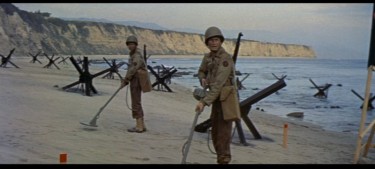 RICHARD TODD – D DAY – The First Paratrooper to land in the invasion.
RICHARD TODD – D DAY – The First Paratrooper to land in the invasion.
In June 11 th 2009 just about 7 months before he died a group of friends put on a lavish birthday party at Grantham House in Lincolnshire. “They’re keeping it all very secret, but I know many senior military and RAF officials are attending, as well as the three county Lord Lieutenants,” he said at the time. Trained at Sandhurst, Todd volunteered for army service in the autumn of 1939, just as his acting career was beginning to take off.
After the war, he became a household name, starring in more than 20 box-office successes including The Dam Busters, Robin Hood and Hasty Heart, in which he played alongside Ronald Reagan. However, the role he cherishes most is the one he played in the British Army’s 6th Airborne Division. During the Normandy invasion in June 1944, his unit was put in charge of securing the east side of the beach landing areas and opening up communication routes for the rest of the Allied troops.
Todd was the first to jump out of the plane. “That wasn’t my idea,” he recalls, “I was supposed to be on plane number 33, but when I got to the aircraft I discovered the pilot was extremely senior and one of the most experienced there. He wanted to go in first, because he had the creme crew.
My immediate thought was: ‘Oh Lord, I’m going to be the first on the ground.'” His moment came at 0040 on Tuesday 6th June. “As I parachuted down, the noise became more overwhelming – machine-guns, shells and mortars. It was impossible to tell who anyone was. I could see shapes but didn’t know if they were the opposition. By luck, the place where I actually dropped was the very track that led to our battalion rendezvous.
So I had no trouble finding it. Other chaps were dropped miles away, in areas inundated by Germans. Some landed in the flooded marshes and drowned. “I was looking back at the incoming aircraft and realised a lot were getting knocked shot down all over the place. If I had been in plane 33 as planned, there was definitely more chance I wouldn’t have survived.”
More than 600 men in the 6th Airborne Division, from the 7th Parachute Batallion, jumped from planes that night, but according to Richard Todd, only around 160 made it to the RV. From there, they were led by commanding officer Lt Col Geoffrey Pine-Coffin towards the bridges over the river Orne and the Caen canal. “We lost a few more en route, and then even more getting from one bridge to the other. It was swampy ground, and a lot of chaps were caught out in the floods and mud.” The bridges had already been seized by a glider force, led by Major John Howard.
The task for Richard Todd and his team was to stop the German forces getting reinforcements to the beach. “We got to Pegasus Bridge at the same moment as the German reaction opened up. There was a lot of firing and we lost another 65 men on the bridges.” Exhausted, they carried on fighting for 21 hours and weren’t relieved until 10pm the following night.
Eighteen years after the events at Pegasus Bridge, Todd went on to play Major Howard in the 1962 war film, The Longest Day, alongside John Wayne, Richard Burton and Robert Mitchum.
He has strong feelings for how the world’s largest single-day amphibious invasion was depicted on screen. “I think I prostituted myself a little bit with my role in that. I’m very glad I did it, but like many blockbusters, drama gets added. The set was very realistic which made it emotional, but my main gripe is that in the film, the gliders got too much kudos and not enough was given to the Paras. Too much credit went to Major Howard when the real hero of the day was our commanding officer, Lt Col Geoffrey Pine-Coffin.”
Richard Todd above with Madame Arlette Gondrée at Pegasus Bridge. She had been a little girl and her family owned the café close to Pegasus Bridge when he first met them after the bridge had been recaptured. They were in fact re-united on the ‘This Is Your Life’ show with Richard Todd the subject in 1988 when it was recorded at The Theatre Royal, Windsor where Richard was touring with a stage production.
This picture ABOVE was taken in 2005
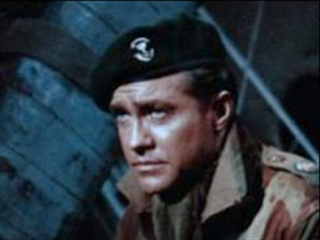
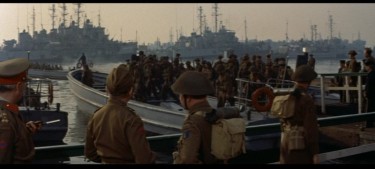
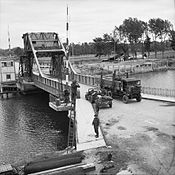
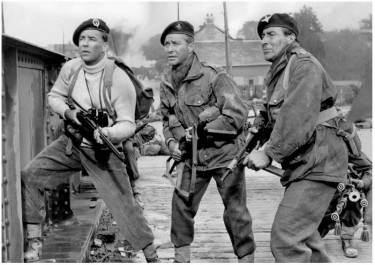
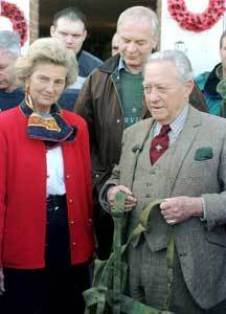
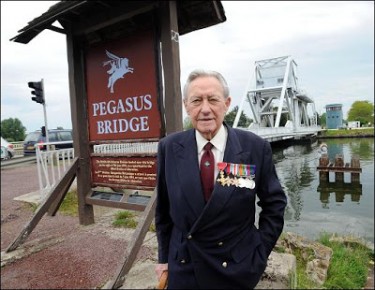
I’ve just been writing about this film on my Facebook page, accompanied by a Front of House still from the film. Here is what I had to say: “When I went to see this film at the Focus cinema, Longton, Stoke on Trent on Thursday, September 12th, 1957, it marked the first time that I, then aged 10 and a half, had gone to the pictures on my own. The film was an eternal triangle love story set against a background of the preparations for the Normandy landings in June, 1944, which, when this film was released, had happened only twelve years earlier. Set in England as it prepared for the invasion, but filmed in California, the film told of the love of married American Captain Brad Parker (Robert Taylor) for English girl Valerie Russell (Dana Wynter), who is engaged to be married to English Colonel John Wynter (Richard Todd) and the film posed the question of which of the two would get killed in the forthcoming battle and not get the girl. I had recently met and fallen in hurtful unrequited love a with local girl of my age, Ann Barlow, and the music in the film by Lyn Murray was very haunting in the romantic interludes and reflected just how I felt in my feelings for Ann and it also featured the hit song of 1944, “You’ll Never Know”.
That side of the film is what I remember it for. But sixty-two years later in 2019, I can see the flaws in the rest of the film. Notwithstanding the usual hilariously inaccurate Hollywood view of wartime London, there were scenes in it that must have been so insulting to British war veterans who went to see the film that it must have gone down like a lead balloon with them and it’s a wonder that the film didn’t get banned shortly after release, as “Objective Burma” had been. In one scene, a group of American G.I.s, fresh over on the troop ship, were seen making fun of a Home Guard platoon as they drilled in a village square and in another, one American soldier says to Captain Brad Parker “I don’t go for those Limey’s. They talk fast and fight slow”. I can’t remember if I noticed how insulting this was to the British army when I went to see the film in 1957, but I certainly notice it now and I don’t like it one little bit. I hope whoever was responsible for these scenes was reprimanded over them at the time. They should never have been included in the final release version of the film”.
David. Thanks for your comments and very interesting they were. As regards comments that ‘disappear’ I really have no idea why this has happened and will have another word with the people that deal with our site. I can only apologise. Neil
I uploaded the above comment on Wednesday, June 5th, but this morning (June 6th) I noticed it had mysteriously disappeared. So I had to upload it again. Why do comments disappear on here? It’s not the first time this has happened.
There’s certainly something odd going on about the disappearing posts, Neil. I thought that only you could delete comments on your own page, but it seems that someone else on Word Press can delete them as well. Maybe you get a lot more comments than you’re aware of, but when the commenters see their posts disappear, they don’t comment again.